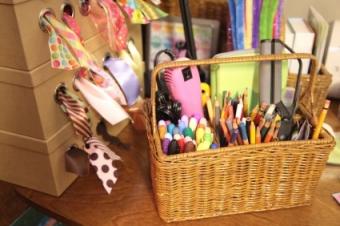
Finding the right craft room organization system will help you enjoy your projects easily and efficiently so you can spend more time crafting and less time searching for tools, materials, and patterns. Having a craft room is not enough; it has to be organized or you will end up with a variety of unfinished projects in a cluttered room instead of a neat supply area and completed projects to share.
Keys to an Organized Craft Room
There are two principle factors that decide whether a craft or sewing room is organized or not: ease and accessibility. The room should be easy to keep organized and materials should be easy to find. Difficult filing or storage systems will create frustration and a chore-like feeling instead of enjoyment.
Similarly, all materials should be readily accessible so no project requires a lot of digging or reshuffling to reach specific tools or materials. The most used tools and materials should be the easiest to access, while less frequently used materials can be stored in more out of the way nooks.
Ideas for Craft Room Organization
The most important thing to remember when organizing your craft room - as with any home organization - is to choose an organizational system that works for you. Not every type of organization is suitable for every type of craft, and if you enjoy several crafting hobbies you may need several different systems of organization.
- Decluttering: When you first begin to organize your craft room, eliminate old materials, leftover bits of projects, and patterns you are no longer interested in completing. By decluttering your craft materials, you will free up a lot more space to be efficiently organized.
- Project Area: Your room should have one central area where you can work on current projects. The surface area of the table should give plenty of workspace, and needed materials should be able to be temporarily stored nearby for whenever you have a moment to work on the project.
- Surface Area: The table workspace area you use for ongoing projects is most efficient if everything is within easy reach. Tables shaped like a U, T, or L are most efficient and maximize your workspace and storage area. If you don't have a shaped table, add on to a basic table with freestanding worktables or other surfaces that can be moved if necessary.
- Lighting: Natural light is most comfortable to work with, so choose a craft room with large windows or skylights and position your workspace area near the best light sources. Fluorescent lights also provide good, bright lighting, and you may want to include magnifying glasses with lights or lights that can be repositioned to help with different projects.
- Seating: Wheeled office chairs can help you easily access all your craft materials in a well organized room. The chair should also be comfortable and at the right height relative to your workspace area.
- Brainstorming: If you have several craft hobbies you enjoy, a bulletin board or chalk board for jotting down new ideas can be a useful way to keep organized instead of using scraps of paper that can be lost or tossed out accidentally.
- Labels: Clear plastic bins and easy-to-read labels are perfect for crafters. Label all storage bins clearly, but do not use unusual abbreviations that you may forget if you don't work on the project frequently.
- Immediate Access: If there are specific tools and materials that you use with most projects, such as scissors, a glue gun or a small sewing kit, they should be stored in an immediately accessible area. You can also opt for a wall or drawer organizer for these materials and can change them to reflect your ongoing project needs.
Storage
The most important thing to consider when creating your craft room organization system is appropriate storage. All materials will need to be suitably stored so they are easy to find and use as well as being protected from dust or damage. Find a system that fits your budget but remember, cheap storage systems leave more money to spend on crafts supplies.
Storage tips for your craft room include:

- Use clear containers that can be labeled, stacked, or rearranged for different projects.
- Arrange similar materials in a logical way, such as sorting threads by color or beads by type and size.
- Use all available space for storage, including over-the-door racks, window benches, closets, and wall pockets.
- Choose easy to access storage containers, such as revolving trays to reach items in the back of a shelf without moving everything.
- Use containers that are appropriately sized for each material so you aren't tempted to mix different items together in a too-large container.
Try to find storage solutions that are made for your hobby.
- Rolling carts with shallow drawers are perfect for scrapbook papers.
- Sewing machine and serger trolleys not only store machines, they make them easy to take to classes.
- Hanging organizers with pockets hold jewelry findings and materials.
- Ribbon dispensers can keep ribbon from tangling while still keeping it handy.
Keeping Your Craft Room Organized
Once you have organized your craft room, it is essential to keep it organized. Don't put off putting materials away. Take out the trash, tidy up the room, and keep materials in their proper places to ensure the next time you use the craft room, you can find everything easily. Furthermore, make the craft room and off-limits space for children and pets to ensure there are no accidental messes or mix ups.
Find the Right System
The right craft room organization can make indulging in your hobbies easy, efficient, and enjoyable. Find an organizational system that works for you and stick with it, and you'll be able to enjoy your crafting hobbies more than ever.







